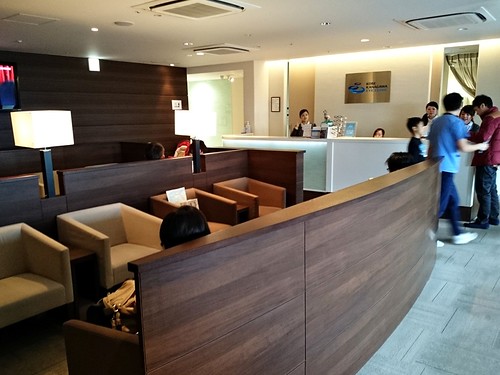Sunday. I still had white veiling glare and halos the morning after surgery, though they had become thinner and less pronounced. My left eye had cleared up well over night and I no longer had much double vision or blur; meanwhile, the right eye had gotten a bit worse than the day before.
I had surgery at the main clinic in Kobe, but I had the day-after checkup at the clinic in Umeda. By the time we got there, both eyes were getting worse again. Fluctuations, we have them. I had 0.8 and 0.9 visual acuity; good but not great(1). Of course, I had 0.06 and 0.08 before LASIK so the improvement was already like night and day.
I had "bandage" contact lenses after the surgery to protect the corneal flaps. I got the right lens removed, but the physician thought it best to keep the left contact lens for a few more days. I got cleared to wash my face and hair again, and that's a great relief. It's amazing how much your scalp can itch when you know you can't wash your hair.
Tuesday. Today I had a quick appointment to check my left eye. It's healing nicely so the contact was removed. I also had a new vision test, and I now have 1.5 in my left eye and 2.0 (!) in my right. I suspect that's a fluke; my vision is still fluctuating, and we might have just caught the right eye at one extreme. Anything from 1.2 upwards will make me happy.
People worry a lot about night vision after LASIK. The causes of poor night vision are mostly second-order astigmatism and refraction from the edges of the flap. Wavefront-guided LASIK removes most second-order astigmatism, and laser-cut flaps should give thinner edges with less scarring, so night vision shouldn't be too affected.
When I wore glasses I used to have some haloing, glare, double vision and starbursts at night. If I wore contacts it was much worse. All I have now are large, faint, soft halos around light sources that are easy to ignore, and that should mostly disappear as my eyes heal. My night vision is already much better than when I wore glasses, and I expect it to improve further still. It is absolutely no problem for me in other words.
I do still have a bit of ghosting in my left eye. The cause could be inflammation, dryness, the still-healing flap or aftereffects from the contact lens, in which case it'll go away. Or it could be residual astigmatism, in which case it won't. It's nothing like my previous astigmatism, and not really noticeable unless I look for it. Still, I hope it will disappear over time.
I'll have the one-week appointment on Friday, then another one a month from now. I'll use the protective glasses and the three eye drops the rest of the week, then switch to just a mild anti-inflammatory agent for a week after that.
Apparently I shouldn't swim, use a sauna or visit an onsen for two weeks; that's fine. I also can't use eye-lash extensions or do violent sports for at least a month; I'll do my best to contain my disappointment.
#1 1.0 is normal vision, and Sweden requires at least 0.5 for driving. Some countries use a reciprocal like "20/20", which means "at 20 feet you see the same detail as the average person at 20 feet". The decimal values used in Japan, Sweden and many other places is simply the result of carrying out that division. So, 1.0 = 20/20 (or 6/6 in meters); 0.8 would be 20/25; 1.5 would be 20/15 and so on. Same thing, different notation.




By following your series of posts on LASIK plus some curiosity fuelled searching I've learnt quite a lot about LASIK.
ReplyDeleteWavefront LASIK looks very good to me (sorry for the pun). And quite a progress compared to previous forms of the procedure.
Quite informative to this (possible) future LASIK patient, in any case, interesting.
I should look into the way of measuring aberrations and vision.
Again, glad to hear it's (slowly) healing and getting over the usual ups and downs of post-surgery week.
The "can't wash face & hair" is a quite annoying limitation. I suffered that too, and isn't nice... I found facial oils much more annoying to me (perhaps being a late teen worsens it)
Too bad you can't take a nice warm onsen, done a quick search about the term and it seems very relaxing! I hope you are fine with this period of combat sport withdrawal (just loved the punchline at the end).
The measurement is fairly simple in principle.
ReplyDeleteIf you shine a grid of lights through a perfect lens, the lights will form a grid on the surface they hit behind it. If the lens is uneven, the points going through the uneven patch will have moved relative to the others. If you assume a linear dependency you can easily figure out the unevenness the lens must have from that (it's not actually linear, I think, but the difference is probably too small to worry about)
So they have a actual, real grid of LED lights that they shine into your eye, and a (I suppose) a camera looks through the eye to see where the resulting light spots end up on your retina. There's the additional complication that you're looking through the same faulty lens twice, so to speak, but you can compensate for that.
I think that perhaps measuring it has never been the issue; instead it's improvements in controlling the laser so you can make use of that information that's made this possible now.
"The "can't wash face & hair" is a quite annoying limitation. I suffered that too, and isn't nice... "
Well, it was only for one night, really. I'd washed my hair the same morning already so I didn't need it or anything; it was just the thought that I wasn't allowed :)
"I hope you are fine with this period of combat sport withdrawal"
Oh, that's no problem. But how am I ever going to show my face at the next weekly seminar without my eye-lash extensions!? The others may think I'm no longer *gasp* fabulous! *faints dramatically*